Philipp Ollendorff – Master Gunmaker
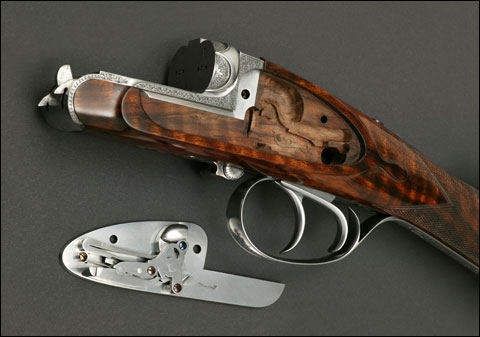
I was walking down the aisles at the 2007 Safari Club International Convention where the high grade guns and gunmakers were concentrated. I had just passed Hartmann & Weiss on my left, made a turn by the stunning Purdey exhibit to go up the aisle to my left. I said ‘hello’ to Steve Lamboy at Zoli, kibitzed with my long-time pals at William, Larkin & Moore’s extensive exhibit and began to amble toward the far wall to find my friend, Dale Tate, to view his exquisite custom hammer shotguns.
Then I stopped in mid stride.
On my right, placed on a red felt cloth on top of a large glass display case was a bar-in-wood hammerless top-lever 12 bore in the MacNaughton style. As the expression goes, it took the old breath away. The gun was heavy, in the eight pound range, designed as a pigeon gun. It was more than gorgeous. It was mesmerizing. It attracted my hands as a magnet attracts iron filings. The wood glowed like a sunset; the aesthetics were perfect. The theoretical firm of Aristotle and Plato could not have constructed a more pleasing shape even if they outsourced the design to the Greek gods.
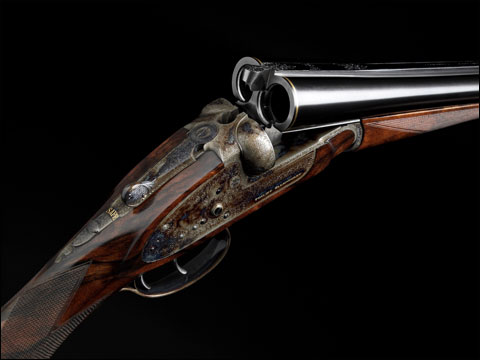
Philipp Ollendorff extended his hand, shook mine with a confident grip of moderate strength and introduced himself. I pulled my yellow legal pad from my SCI cloth bag, found a pen in one of the many pockets of my vest and began asking questions and furiously scribbling answers. Thus began a friendship that lasts to this day.
I have spent time with Philipp and his elegant wife, Silke, at every SCI convention since, except 2011, which regrettably, I was unable to attend. We speak and hug like old friends. I admit unabashedly that, from the moment we met, I really liked these two people, enough to write an article about them and Philipp’s firm for Safari Magazine a year or so after we met.
Each visit with Philipp is like a tutorial on the nuances of custom gunmaking. The finest firearms have much in common. They are gorgeous, perfectly balanced, boast jaw-dropping wood and impeccable craftsmanship. But far more intriguing to me, and what inspires me to write about fine guns, are their design philosophies and the solutions to mechanical and aesthetic challenges. I want to know the brainpower behind the designs and how the firearms of one great maker differ from another.
Philipp explained the challenges inherent in crafting this bar-in-wood shotgun. His initial problem was the absence of any historical patterns or precedent for this style of gun. Previous bar-in-wood guns were non-ejector hammerguns.
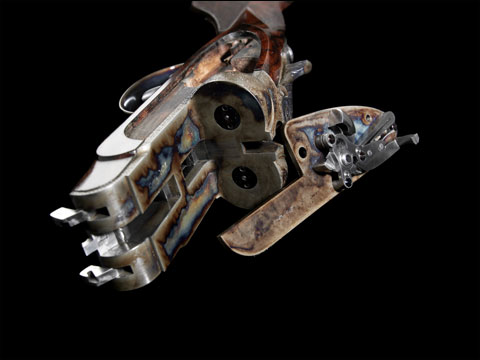
Thus, his hammerless gun had to be an original prototype, for no patterns or templates existed. “The gun is born in my head,” he explained. Searching for the right English words and asking Silke for assistance, Philipp added, “A picture in my mind flows from my brain into my hands. Then I start making the gun.”
Although daunting, Philipp relished mastering such challenges, because “that is in my eyes what gun making was and should be.” The wood in a bar-in-wood gun covers the action on the bottom and forward to the hinge pin. The trigger plate and the action have no contact because wood is between them.
The technical skill necessary to inlet the bar-in-wood action is not present in traditional sidelock or boxlock stocks. With this design, the unified forward part of the single piece of wood must be fitted perfectly to the barrels and to the action as well as to the locks within the action.
Try to fathom the expertise required to craft the shape of the stock along with the precise measurements of the inletting so that every part is in the right position while simultaneously shaping the stock to achieve the proper drop and cast.
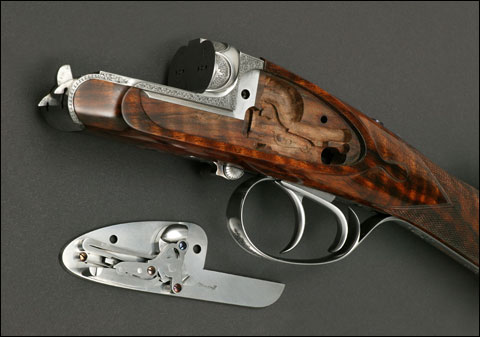
A hammerless ejector gun, by definition, needs cocking levers to make the ejectors operate. Philipp’s challenge in this design segment was figuring out the size of the action underneath the wood that would incorporate the cocking levers and the inletting yet maximize strength and achieve elegant lines.
There is no room for error, Philipp emphasized, because the stock, usually supplied by his customers, is both special and expensive. Mistakes carry big prices. “It’s not a secret. Every working step you have to think twice, three times. If something goes wrong, you have to throw the whole thing away.” This design demanded that Philipp draw upon skills possessed only by the most finely-honed gunmakers, including what he modestly calls “the ability to make the right decision.”
As in any exquisitely crafted work—music, poetry, drama—nothing should be taken away and nothing further should be added. Philipp handed to me a side-lever 12 bore shotgun made in the classic British style, an anomaly in the Alps.
This sidelever is reminiscent of a Joseph Lang or Stephen Grant or Watson Brothers rather than what Clair Kofoed calls a “cuckoo clock gun.” The traditional Austrian and German hunting shotguns and rifles exhibit deeply chiseled wood and steel and somewhat cartoonish engraving. Abandoning the Germanic heritage, Philipp’s guns are in the classical English tradition.
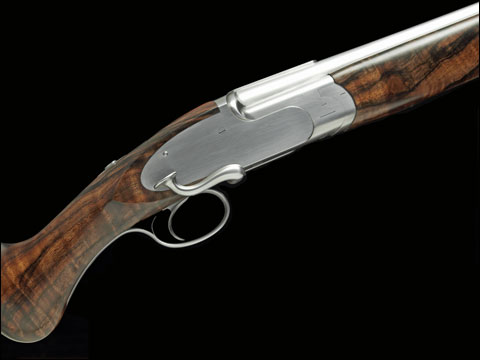
In addition to the pigeon and sidelever guns, Philipp displayed an elegant kipplaufbuchse, the traditional single-shot stalking rifle. Each year he had another example. Each was gorgeous, often borrowed from a client who allowed him to display the gun at SCI before taking possession irrevocably. This kipplaufbuchse also had a bar-in-wood action but featured an external hammer. A creative design grace note was a lever on the side to disengage the ejector mechanism.
A Gunmaker’s History and Inspiration
Philipp and Silke live in Scharnitz, Austria, a small pastoral village in the Tyrolean Mountains, about a half hour’s drive from the Innsbruck airport. Philipp and Silke were introduced by mutual friends and, as they told the story, fell in love at first sight. They married in 1997. “He was very good looking and a good conversationalist,’ Silke said of Philipp. Philipp effused, in slightly awkward English, that no matter how beautiful his guns, they paled in comparison to her.
Philipp was the first Austrian gunmaker I’d met who was not from Ferlach, the historic arms center in southern Austria. He was born in Oberammergau, the city known for passion plays and artisans. Philipp attributes his artistic gunmaking skills to his grandfather, a bronze sculptor in the city. In the mid-1980’s Philipp went to Ferlach to train at the Ferlach School for gunmakers and stockers. During the next four years or so he worked for several gunmakers in Ferlach and then as a stockmaker for Hartmann & Weiss in Germany.
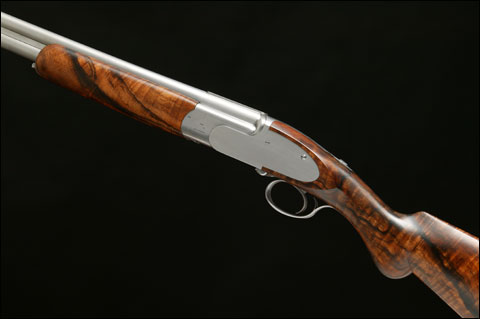
Philipp returned to Ferlach to obtain a Master’s Degree and stayed to work as an action filer. Although a young gunmaker, he had the wisdom to understand the importance of working for different companies to gain maximum experience and skill. His vision to make guns in his own style and under his own name propelled him to learn everything about the trade, making locks, triggers, ejectors, stocks and action filing.
Gunmaking, Philipp says, is more than craftsmanship. Rather, it is the transcendant blend of art, enthusiasm, discipline, patience and creativity. His approach to the art embodied Aristotle’s philosophy: “We are what we repeatedly do. Excellence, then, is not an act but a habit.”
His decision to move to Scharnitz was somewhat unorthodox. Unlike Ferlach, for example, Scharnitz has no gunmaking history. However, it has a hunting tradition that can be traced to the icemen. Not too far from his home is Karwendel National Park, one of the largest parks in middle Europe. For generations Karwendel has been the hunting grounds for well-connected families.
Philipp draws inspiration from the park during his habitual long walks with his dogs. The solitude, the aroma of vegetation, the abundant wildlife—chamois, eagles, roe deer and red deer, murmeltier, a kind of large groundhog, and auerhahn, alleged to be the world’s largest grouse—inspire thoughts of guns designs to percolate in his mind.
Philipp constructs almost every part of his guns, even the screws and springs, handmade but perfect. His barrels are made of finest chromium steel and steel of a slightly different hardness is used for the action, sears, tumblers, lockplates and other parts. His guns are sent to outworkers for case hardening and coloring, checkering and bluing.
“I don’t have to buy a million dollar digitalized computerized machine,” he tells me with pride. “I am a waffenschmied, a gunmaker.” Then, with lament in his voice, he adds, “And that is what’s getting lost.”
Despite his world renown, Philipp is a man of humility. He speaks humbly of his success at the Safari Club Conventions and expresses his gratitude for his clients. He values the lasting relationship that develops when a customer orders one of his unique guns. “I remember every customer and I know that the customer is thinking about me.”
A few months ago Philipp sent me photographs of his most recent creations. I share them with the readers of Shotgun Life. Philipp’s individualized style persuades without words that his guns are special and of unsurpassed quality. Each is a prototype and each prototype is like no other. Each has a soul.
Philipp’s pursuit of perfection is unrelenting. He is essentially a one-person operation. He does outsource tasks such as case hardening, stock shaping, checkering and, of course, engraving. Philipp is, however, one of the finest makers I’ve encountered and, important to me, his grace and smile are unsurpassed. He told me that when he finally closes the case to deliver a gun to his client, his thought is “How can I make the next one better?” That sentiment infuses the true meaning of owning a Philipp Ollendorff gun.
Michael Sabbeth is a lawyer in Denver, Colorado whose practice emphasizes estate planning. He lectures nationally to bar associations on the ethics of rhetoric as a legal competence and a litigation skill. He also presents to private companies and civic groups on the use of rhetoric as a management skill. As a freelance writer he has been published in many of the finest shooting and hunting magazines, including Double Gun Journal, Shooting Sportsman, Safari Magazine and Sporting Classics. He is pleased to have written many of the most comprehensive articles on the Beretta family and its fine firearms. He is also author of the groundbreaking book “The Good, The Bad & The Difference – How to Talk With Your Children About Values.” To find out more about the book, please visit http://kidsethicsbook.com.
Useful resources:
The Phillipp Ollendorf web site

Michael Sabbeth is a lawyer in Denver, Colorado. He lectures on ethics and rhetoric to law associations and civic and business groups. He is the author of the The Good, The Bad & The Difference: How to Talk with Children About Values. Please visit his website at www.kidsethicsbook.com.


Comments